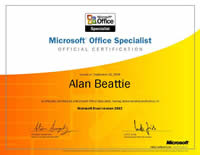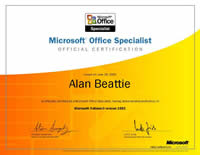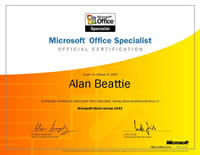Microsoft Office Specialist XP (2002)




Certifications

Microsoft Office Specialist: Access 2002

Microsoft Office Specialist: Excel 2002

Microsoft Office Specialist: Excel Expert 2002

Microsoft Office Specialist: Outlook 2002

Microsoft Office Specialist: PowerPoint 2002

Microsoft Office Specialist: Word 2002

Microsoft Office Specialist: Word Expert 2002

Microsoft Office Specialist: Master 2002

Microsoft Office Specialist: Master Instructor 2002
Skills
Word 2002
Inserting and Modifying Text
- Insert, modify, and move text and symbols
- Apply and modify text formats
- Correct spelling and grammar usage
- Apply font and text effects
- Enter and format Date and Time
- Apply character styles
Creating and Modifying Paragraphs
- Modify paragraph formats
- Set and modify tabs
- Apply bullet, outline, and numbering format to paragraphs
- Apply paragraph styles
Formatting Documents
- Create and modify a header and footer
- Apply and modify column settings
- Modify document layout and Page Setup options
- Create and modify tables
- Preview and Print documents, envelopes, and labels
Managing Documents
- Manage files and folders for documents
- Create documents using templates
- Save documents using different names and file formats
Working with Graphics
- Insert images and graphics
- Create and modify diagrams and charts
Workgroup Collaboration
- Compare and Merge documents
- Insert, view and edit comments
- Convert documents into Web pages
Excel 2002
Working with Cells
- Use Undo and Redo
- Clear cell content
- Enter text, dates, and numbers
- Edit cell content
- Go to a specific cell
- Insert and delete selected cells
- Cut, copy, paste, paste special, and move selected cells
- Use the Office Clipboard
- Use Find and Replace
- Clear cell formats
- Work with series (AutoFill)
- Create hyperlinks
Working with Files
- Use Save
- Use Save As (different name, location, and format)
- Locate and open an existing workbook
- Create a folder
- Use templates to create a new workbook
- Save a worksheet/workbook as a Web Page
- Send a workbook via e-mail
- Use the Microsoft Office Assistant
Formatting Worksheets
- Apply font styles (typeface, size, color, and styles)
- Apply number formats (currency, percent, dates, and commas)
- Modify row and column size
- Modify alignment of cell content
- Adjust decimal places
- Use the Format Painter
- Apply AutoFormat
- Apply cell borders and shading
- Merge cells
- Rotate text and change indents
- Define, apply, and remove a style
Page Setup and Printing
- Preview and print worksheets and workbooks
- Use Web Page Preview
- Print a selection
- Change page orientation and scaling
- Set page margins and centering
- Insert and remove a page break
- Set print, and clear a print area
- Set up headers and footers
- Set print titles and options (gridlines, print quality, and headings for rows and columns)
Working with Worksheets and Workbooks
- Insert and delete rows and columns
- Hide and unhide rows and columns
- Freeze and unfreeze rows and columns
- Change the zoom setting
- Move between worksheets in a workbook
- Check spelling
- Rename a worksheet
- Insert and delete worksheets
- Move and copy worksheets
- Link worksheets and consolidate data using 3-D references
Working with Formulas and Functions
- Enter a range within a formula in a drag-and-drop operation
- Enter formulas in a cell and use the formula bar
- Revise formulas
- Use references (absolute and relative)
- Use AutoSum
- Use the Paste Function to insert a function
- Use basic functions (AVERAGE, SUM, COUNT, MIN, and MAX)
- Enter functions using the Formula Palette
- Use date functions (NOW and DATE)
- Use financial functions (FV and PMT)
- Use logical functions (IF)
Using Charts and Objects
- Preview and print charts
- Use the Chart Wizard to create a chart
- Modify charts
- Insert, move, and delete an object (graphic)
- Create and modify lines and objects
PowerPoint 2002
Creating a Presentation
- Delete slide
- Create a specified type of slide
- Create a presentation from a template or a wizard
- Navigate among different views (slide, outline, sorter, and tri-pane)
- Create a new presentation from existing slides
- Copy a slide from one presentation into another
- Insert headers and footers
- Create a blank presentation
- Create a presentation using the AutoContent Wizard
- Send a presentation via e-mail
Modifying a Presentation
- Change the order of slides using Slide Sorter view
- Find and replace text
- Change the layout for one or more slides
- Modify the Slide Master
- Modify slide sequence in the outline pane
- Apply a design template
Working with Text
- Check spelling
- Change and replace text fonts (individual slide and entire presentation)
- Enter text in tri-pane view
- Import text from Microsoft Word
- Change the text alignment
- Create a text box for entering text
- Use the Wrap text in Text Box feature
- Use the Office Clipboard
- Use the Format Painter
- Promote and Demote text in slide and outline panes
Working with Visual Element
- Add a picture from the Clip Art Gallery
- Add and group shapes using WordArt or the Drawing Toolbar
- Apply formatting
- Add text to a graphic object using a text box
- Scale and size an object including clip art
- Create tables within PowerPoint
- Rotate and fill an object
Customizing a Presentation
- Add AutoNumber bullets
- Add speaker notes
- Add graphical bullets
- Add slide transitions
- Animate text and objects
Creating Output
- Preview presentation in black and white
- Print slides in a variety of formats
- Print audience handouts
- Print speaker notes in a specified format
Delivering a Presentation
- Start a slide show on any slide
- Use on screen navigation tools
- Print a slide as an overhead transparency
- Use the pen during a presentation
Managing Files
- Save changes to a presentation
- Save as a new presentation
- Publish a presentation to the Web
- Use the Microsoft Office Assistant
- Insert hyperlink
Access 2002
Creating and Using Database
- Create Access databases
- Open database objects in multiple views
- Move among records
- Format datasheets
Creating and Modifying Tables
- Create and modify tables
- Add a predefined input mask to a field
- Create Lookup fields
- Modify field properties
Creating and Modifying Queries
- Create and modify Select queries
- Add calculated fields to Select queries
Creating and Modifying Forms
- Create and display forms
- Modify form properties
Viewing and Organizing Information
- Enter, edit, and delete records
- Create queries
- Sort records
- Filter records
Defining Relationships
- Create one-to-many relationships
- Enforce referential integrity
Producing Reports
- Create and format reports
- Add calculated controls to reports
- Preview and print reports
Integrating with Other Applications
- Import data to Access
- Export data from Access
- Create a simple data access page
Outlook 2002
Messaging
- Originate and respond to E-mail and instant messages
- Attach files to items
- Modify e-mail message settings and delivery options
- Create and edit contacts
- Accept, decline, and delegate tasks
Scheduling
- Create and modify appointments, meetings, and events
- Update, cancel, and respond to meeting requests
- Customize Calendar settings
- Create, modify, and assign tasks
Organizing
- Create and modify distribution lists
- Link contacts to other items
- Create and modify notes
- Organize items
- Organize items using folders
- Search for items
- Organize items using folders
- Search for items
- Save items in different file formats
- Assign items to categories
- Preview and print items
Word 2002 Expert
Working with Paragraphs
- Apply paragraph and section shading
- Use text flow options (keeping lines together)
- Sort lists, paragraphs, and tables
Working with Documents
- Create and modify page borders
- Format first page differently than subsequent pages
- Use bookmarks
- Create and edit styles
- Create watermarks
- Use Find and Replace with formats, special characters, and nonprinting elements
- Balance column length (using column breaks appropriately)
- Create or revise footnotes and endnotes
- Work with master documents and subdocuments
- Create and modify a table of contents
- Create cross reference
- Create and modify an index
Using Tables
- Embed worksheets in a table
- Perform calculations in a table
- Link Microsoft Excel data as a table
- Modify worksheets in a table
Working with Pictures and Charts
- Add bitmap graphics
- Delete and position graphics
- Create and modify charts
- Import data into charts
Using Mail Merge
- Create main document
- Create data source
- Sort records to be merged
- Merge main document and data source
- Generate labels
- Merge a document using alternate data sources
Using Advanced Features
- Insert a field
- Create, apply, and edit macros
- Copy, rename, and delete macros
- Create and modify form
- Create and modify a form control (for example, add an item to a drop-down list)
- Use advanced text alignment features with graphics
- Customize toolbars
Collaborating with Workgroups
- Insert comments
- Help protect documents
- Create multiple versions of a document
- Track changes to a document
- Set default file location for workgroup templates
- Round trip documents from HTML
Excel 2002 Expert
Importing and Exporting Data
- Import data from text files (insert, drag-and-drop) operations
- Import from other applications
- Import a table from an HTML file (insert and drag and drop operations, including HTML round tripping)
- Export to other applications
Using Templates
- Apply templates
- Edit templates
Create templates
- Using Multiple Workbooks
- Use a workspace
- Link workbooks
Formatting Numbers
- Apply number formats (accounting, currency, and number)
- Create custom number formats
- Use conditional formatting
Printing Workbooks
- Print and preview multiple worksheets
- Use the Report Manager
Working with Named Ranges
- Add and delete a named range
- Use a named range in a formula
- Use Lookup Functions (HLOOKUP or VLOOKUP)
Working with Toolbars
- Hide and display toolbars
- Customize a toolbar
- Assign a macro to a command button
Using Macros
- Record macros
- Run macros
- Edit macros
Auditing a Worksheet
- Work with the Auditing Toolbar
- Trace errors (find and fix errors)
- Trace precedents (find cells referred to in a specific formula)
- Trace dependents (find formulas that refer to a specific cell)
Displaying and Formatting Data
- Apply conditional formats
- Perform single and multilevel sorts
- Use grouping and outlines
- Use data forms
- Use subtotaling
- Apply data filters
- Extract data
- Query databases
- Use data validation
Using Analysis Tools
- Use the Microsoft PivotTable auto format
- Use Goal Seek
- Create Microsoft PivotChart reports
- Work with Scenarios
- Use Solver
- Use data analysis and PivotTable
- Create interactive tables for the Web with PivotTable
- Add fields to a table using the Web browser
Collaborating with Workgroups
- Create, edit, and remove a comment
- Apply and remove worksheet and workbook protection
- Change workbook properties
- Apply and remove file passwords
- Track changes (highlight, accept, and reject)
- Create a shared workbook
- Merge workbooks
Microsoft Master
- Word 2002 Expert
- Excel® 2002 Expert
- PowerPoint® 2002
- Outlook® 2002
OR
Access® 2002
